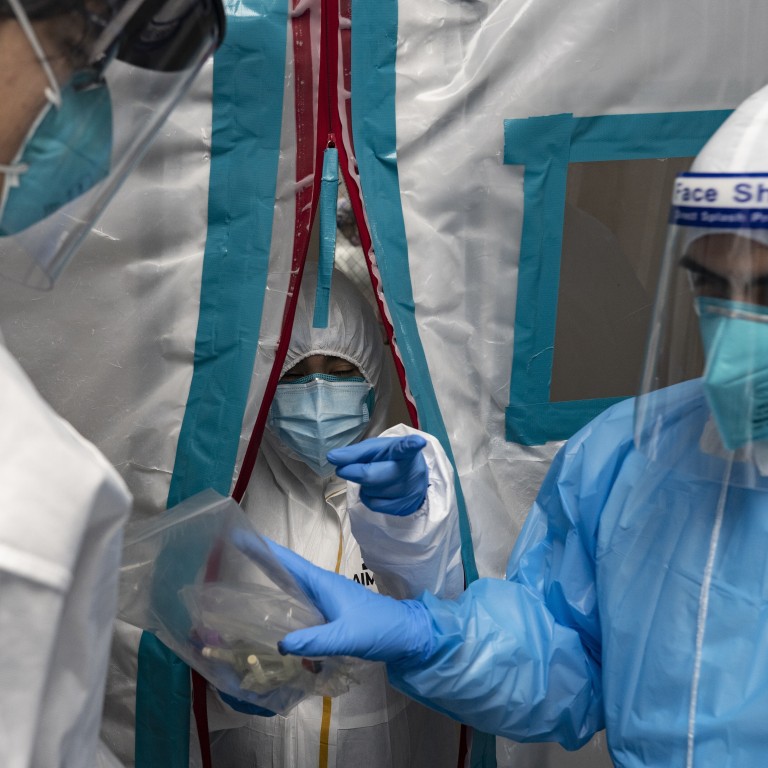
Coronavirus: 10 million Americans infected as Europe’s hospitals buckle under strain
- By Monday morning, total US deaths had surpassed 237,000, with hundreds of thousands of more projected over the coming winter months
- The virus has also been surging in Europe, which is fast running out of intensive care beds – and the doctors and nurses to staff them
US infections early in the pandemic were concentrated in Seattle, New York and other urban coastal regions, but recent transmission is geographically widespread.
We’re seeing the equivalent of two 747s crashing per day, killing everybody on board
“Ten million cases in a 300 million population tells you we have a long way to go, and a lot more people at risk,” said Dr Georges Benjamin, executive director of the American Public Health Association, adding that the milestone was “a prelude to the hundreds of thousands more deaths we’re projecting”.
By Monday morning, total deaths had surpassed 237,000. The US Centers for Disease Control and Prevention said it expected that figure to grow by around 20,000 over the next two weeks.
“We’re seeing the equivalent of two 747s crashing per day, killing everybody on board,” said Dr Carlos del Rio, a global health epidemiologist at Emory University. “You’d imagine, at some point, someone would say, ‘What’s going on with planes?’ There would be outrage. And I’m not seeing the outrage.”
Federal researchers suspect the pandemic has indirectly led to the deaths of tens of thousands more Americans who avoided hospital care for other illnesses or overdosed on drugs because of psychological stress, for example – bringing the true US death toll closer to 300,000.
Making matters worse, the arrival of winter is expected to drive more people indoors, where poor airflow makes transmission more likely. The Thanksgiving and Christmas holidays could also be troublesome if people break their social distancing habits to gather in large, unmasked groups to share meals.

Intensive care is the last line of defence for severely ill coronavirus patients and Europe is running out of beds, and the doctors and nurses to staff them. In country after country, the burden is nearing and sometimes surpassing levels last seen at spring’s peak.
Filippo Anelli, the head of Italy’s national doctors’ association, said at the current infection rate, there soon will not be enough doctors to go around. The country has a total of 11,000 ICU beds, but only enough anaesthesiologists for 5,000 patients, Anelli said. As of Monday, 2,849 ICU beds were filled nationwide – up 100 from just the day before.
For the average coronavirus patient with serious symptoms, it takes seven to 10 days to go from infection to hospitalisation. Those admitted often need to stay for weeks, even as more patients arrive.

“When a city of millions only has 80, 90 beds left then that can be a critical mass, because you don’t just have Covid-19, there are also traffic accidents, heart attacks, pulmonary embolisms and so forth,” said Dr Uwe Janssens, head of Germany’s Interdisciplinary Association for Intensive Care and Emergency Medicine.
Germany has about 34.5 ICU beds per 100,000 inhabitants, not including the emergency reserve. Italy has 10, while France has 16, he said.
“But a bed, a ventilator and a monitor doesn’t mean the patient can be cared for. When it comes to nurses and specialist staff, Germany is far behind,” he said. “We have a lot of beds but we don’t have enough staff for them.”
Australia may open borders to Asia, parts of China, as virus cases dwindle
Much of Eastern Europe, spared the harrowing wave last spring, is in the same position. Hungary warned its ICU would run out of space by December under the worst-case scenario, and hospitalisations in Poland have risen to three times the levels seen in the spring.
Late last month, American National Guard troops with medical training headed to the Czech Republic to work alongside doctors there, and the mayor of Prague took shifts at a hospital.

